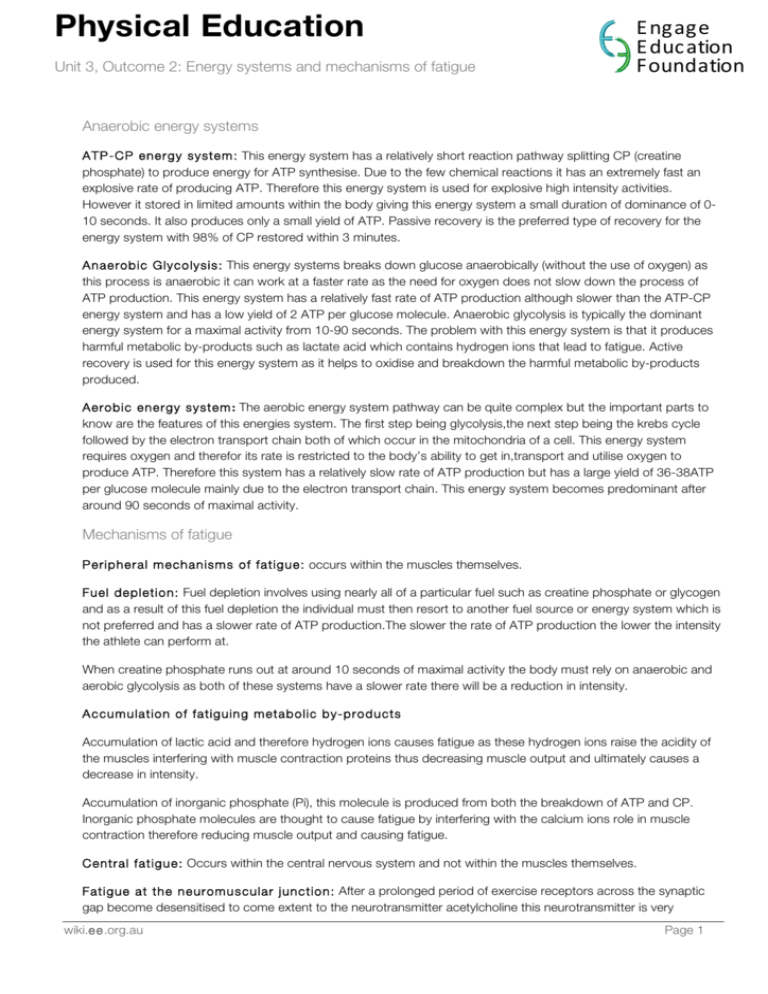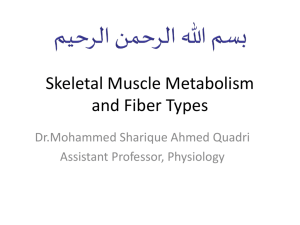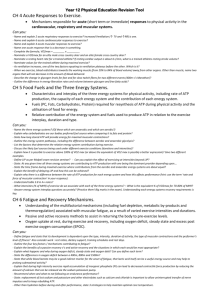PE Unit 3 Outcome 2 - Engage Education Foundation
advertisement

Physical Education Unit 3, Outcome 2: Energy systems and mechanisms of fatigue E ngage E ducation Foundation Anaerobic energy systems ATP-CP energy system: This energy system has a relatively short reaction pathway splitting CP (creatine phosphate) to produce energy for ATP synthesise. Due to the few chemical reactions it has an extremely fast an explosive rate of producing ATP. Therefore this energy system is used for explosive high intensity activities. However it stored in limited amounts within the body giving this energy system a small duration of dominance of 010 seconds. It also produces only a small yield of ATP. Passive recovery is the preferred type of recovery for the energy system with 98% of CP restored within 3 minutes. Anaerobic Glycolysis: This energy systems breaks down glucose anaerobically (without the use of oxygen) as this process is anaerobic it can work at a faster rate as the need for oxygen does not slow down the process of ATP production. This energy system has a relatively fast rate of ATP production although slower than the ATP-CP energy system and has a low yield of 2 ATP per glucose molecule. Anaerobic glycolysis is typically the dominant energy system for a maximal activity from 10-90 seconds. The problem with this energy system is that it produces harmful metabolic by-products such as lactate acid which contains hydrogen ions that lead to fatigue. Active recovery is used for this energy system as it helps to oxidise and breakdown the harmful metabolic by-products produced. Aerobic energy system: The aerobic energy system pathway can be quite complex but the important parts to know are the features of this energies system. The first step being glycolysis,the next step being the krebs cycle followed by the electron transport chain both of which occur in the mitochondria of a cell. This energy system requires oxygen and therefor its rate is restricted to the body’s ability to get in,transport and utilise oxygen to produce ATP. Therefore this system has a relatively slow rate of ATP production but has a large yield of 36-38ATP per glucose molecule mainly due to the electron transport chain. This energy system becomes predominant after around 90 seconds of maximal activity. Mechanisms of fatigue Peripheral mechanisms of fatigue: occurs within the muscles themselves. Fuel depletion: Fuel depletion involves using nearly all of a particular fuel such as creatine phosphate or glycogen and as a result of this fuel depletion the individual must then resort to another fuel source or energy system which is not preferred and has a slower rate of ATP production.The slower the rate of ATP production the lower the intensity the athlete can perform at. When creatine phosphate runs out at around 10 seconds of maximal activity the body must rely on anaerobic and aerobic glycolysis as both of these systems have a slower rate there will be a reduction in intensity. Accumulation of fatiguing metabolic by-products Accumulation of lactic acid and therefore hydrogen ions causes fatigue as these hydrogen ions raise the acidity of the muscles interfering with muscle contraction proteins thus decreasing muscle output and ultimately causes a decrease in intensity. Accumulation of inorganic phosphate (Pi), this molecule is produced from both the breakdown of ATP and CP. Inorganic phosphate molecules are thought to cause fatigue by interfering with the calcium ions role in muscle contraction therefore reducing muscle output and causing fatigue. Central fatigue: Occurs within the central nervous system and not within the muscles themselves. Fatigue at the neuromuscular junction: After a prolonged period of exercise receptors across the synaptic gap become desensitised to come extent to the neurotransmitter acetylcholine this neurotransmitter is very wiki.ee.org.au Page 1 important in initiating muscular contraction hence a decrease in the reception this neurotransmitter will reduce muscular output and lead to fatigue. Central governor theory: Is a theory that proposes that the body intentionally induces fatigue after prolonged exercise in order to protect the body and individual from over exertion. Dehydration: Is a loss of body fluid which occurs during exercise as the body sweats to cool down, this results in a decrease in blood plasma which thickens the blood and can lead to fatigue as a thickening of the blood reduces its oxygen carrying capacity. Energy system interplay At any given time throughout the activity more than one energy system will be contributing to ATP production. The predominant energy system at any given time will depend on the intensity and duration of the different aspect of the activity. wiki.ee.org.au Page 2









